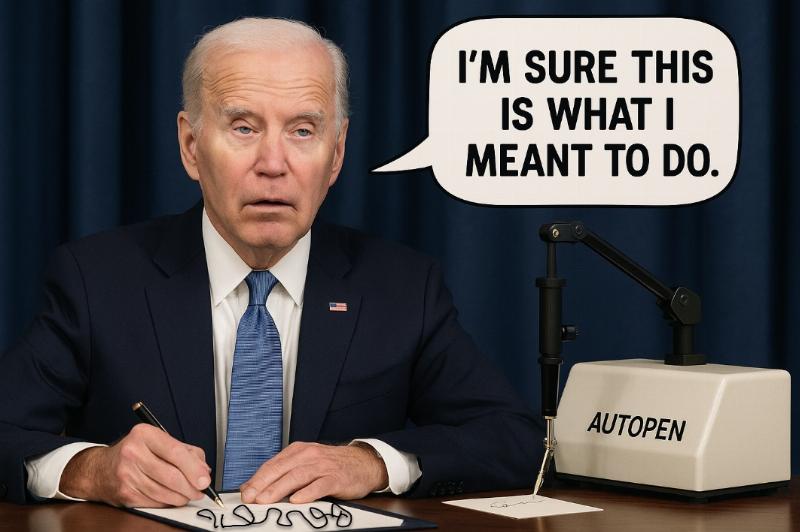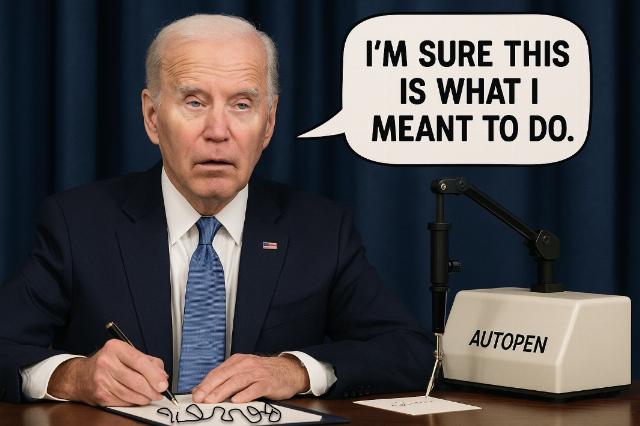


My pet peeve as both a writer and reader is passive voice because it makes writing turgid, but I also hate it because it allows the author to avoid assigning responsibility. Other pet peeves are chronologically confusing or ambiguous writing. When good writers commit these sins, whether they’re doing so consciously or subconsciously, they’re often hiding something.
And that gets us to the instantly infamous New York Times’s essay about its review of the emails documenting how the White House used autopens for the thousands of clemency warrants Biden issued before leaving office, including full pardons for friends and family. Parse the carefully bad writing, and what oozes out is a strong suggestion that Biden’s staff may have abused the Autopen for pardons.

Image created using ChatGPT.
After relaying a short interview with Biden (saying pretty much I didn’t do nothin’ wrong; I was in charge all along), the essay parses the emails it obtained. And that’s where the bad writing begins.
The Biden interview lays the predicate, which is that there were way too many signatures for him to handle manually:
“I made every decision,” Mr. Biden said in a phone interview on Thursday, asserting that he had his staff use an autopen replicating his signature on the clemency warrants because “we’re talking about a whole lot of people.”
However, as you work your way down, you discover that statement is untrue. Some decisions did affect “a whole lot of people,” such as the clemency for “inmates sent to home confinement,” during COVID, and “certain nonviolent drug offenders.”
Those numbered in the thousands, which would justify an autopen. However, those two categories could easily have been handled via a blanket commutation, along the lines of the pardon Jimmy Carter issued to all Vietnam War draft dodgers.
When it came to the 37 commutations of death row sentences, though, there is no reason why Biden could not have signed his name 37 times—or issued a single pardon for all people on federal death row other than three named individuals whom Biden kept on death row because “[t]he offense affected American society as a whole.” (I would say that all indefensible murders affect American society as a whole, but I’m a moral person.)
And then there were the “pre-emptive pardons for members of his [Biden’s] own family and various people who have drawn Mr. Trump’s ire.” And that’s where things get interesting.
Once again, this was a small group, so there was no reason for Biden’s autopen justification; namely, “we’re talking about a whole lot of people.” A functional person could easily have dashed off the signatures for those last pardons, as Biden actually did for Hunter Biden’s pardon.
It's at this point that the narrative gets very poorly written. One of the few straightforward facts is that Stefanie Feldman controlled the autopen itself, but not the decisions about its use. Otherwise, here’s what we learn:
Biden had meetings about pardons and commutations with a variety of “senior aides,” people such as “Mr. Biden’s chief of staff, Jeffrey D. Zients, and Mr. [Ed] Siskel [White House Counsel,” along with “other meeting participants.” At some point, “aides to the senior advisors who had participated in the meetings” would create “blurbs” summarizing Biden’s alleged orders. Significantly,
The assistants who drafted the blurbs were not themselves in the room with Mr. Biden, according to the lists of meeting participants. The emails imply that Mr. Siskel and Mr. Zients relayed what Mr. Biden had said to the assistants, who then documented it.
In other words, the blurbs’ contents are pure hearsay. There is no reason to believe that they accurately reflect what took place during those meetings.
The aides to the senior aides then sent these hearsay blurbs around to all the participants for their review.
When it came to those large-scale clemency grants, this process could take days and include multiple amendments without Biden’s involvement:
Mr. Biden did not individually approve each name for the categorical pardons that applied to large numbers of people, he and aides confirmed. Rather, after extensive discussion of different possible criteria, he signed off on the standards he wanted to be used to determine which convicts would qualify for a reduction in sentence.
Even after Mr. Biden made that decision, one former aide said, the Bureau of Prisons kept providing additional information about specific inmates, resulting in small changes to the list. Rather than ask Mr. Biden to keep signing revised versions, his staff waited and then ran the final version through the autopen, which they saw as a routine procedure, the aide said.
Only after the entire process had finished, including the autopen signatures, was Biden read into the process:
The emails also show that when the White House was preparing to announce clemency grants, communications staff drafted statements explaining the decisions. Mr. Biden had to be shown the drafts, and they could not be released until an aide said he had approved them. On at least one occasion, wording was tweaked because of what an email said was feedback from Mr. Biden.
The article, incidentally, obscures this important chronological point by having the last paragraph quoted preceding the other two. That makes it appear that Biden first approved the changes and then the autopen went to work. However, if you parse this (deliberately?) muddled writing, it’s apparent that the autopen got deployed before Biden was read in.
It doesn’t get better with the pardons to Biden’s friends and family. According to Biden’s ten-minute interview with the Times, “he discussed each of the high-profile individuals with aides.” The example Biden gave was his pardon to Mark Milley because, “We know how vindictive Trump is and I’ve no doubt they would have gone after Mark for no good reason.”
That’s an interesting choice of examples for Biden, given that Milley stated under oath that he had informed the top general in the Chinese People’s Liberation Army that he would immediately inform China if Trump had ordered an attack. Imagine if General Dan Caine, the current Joint Chiefs chair, had the same attitude in advance of the B-2 bombing on the Fordow reactors.
It appears that the same procedure was in place for these pardons as for the mass clemencies: A meeting at which no secretary or court reporter took notes, followed by participants telling aides what happened, leading to a hearsay “blurb” and autopen action.
After the final meeting to pardon Biden’s friends and family and within three minutes of receiving the email with the hearsay blurb, Zients sent a “reply all” email: “I approve the use of the autopen for the execution of all of the following pardons.” It seems Biden was out of this loop, too.
In sum, there is no reliable written record of what Biden said. Instead, senior aides walked out of his office and could have done whatever they wanted, up to and including those autopen signatures, only informing Biden after the fact.
That Biden would support all this after the fact was predictable. Whether he supported any of this before the fact is questionable—and, whether intentionally or not, the good writers at the New York Times who engaged in stunningly disorganized, ambiguous writing want to keep it that way.
